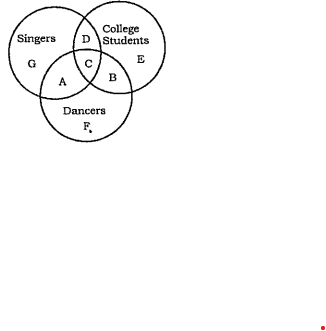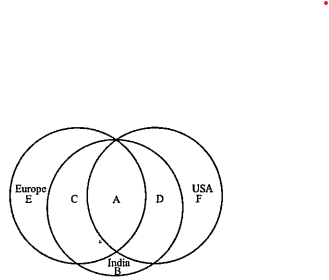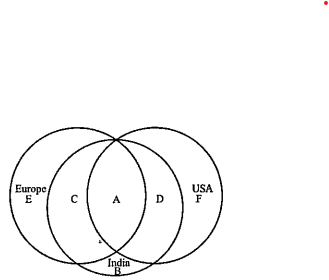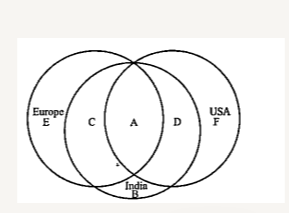You have to take the diagram to be true even if it seems to be at variance from commonly known facts and then decide which of the five alternatives following each question logically follows from the given diagram.

Which of the following represents such dancers who are also singers but not college students ?
1)Only C
2) Only A
3) F and G
4) C and F
5) Only B
2,
Topper's Solved these Questions
Similar Questions
Each question below is based on the given diagram. You have to take the given diagram to be true even if it seems to be at variance from commonly known facts and then decide which of the five alternatives following each question logically follows from the given diagram.

Which of the following represents the graduate population which is not employed in BPO?
1) A and B
2) Only C
3) B and D
4) Only D
5) B and E
View SolutionEach of question given below is based on the given diagram. You have to take the given diagram to be true even if it seems to be at variance with commonly known facts and then decide which of the five alternatives following each question logically follows from the given diagram. The diagram comprises three circles showing people from three different countries who have travelled to either , both or none of the countries mentioned in the diagram.

Which of the following represents those Europeans who have travelled only the USA but not to India?
1) Only C
2) Only A
3) F and C
4) Only D
5)Not illUStrated in the diagram
View Solution
Knowledge Check
In each of the following questions, some statements are given and these statements are followed by two conclusions numbered I and II. You have to take the given statements to be true even if they seem to be at variance from commonly known facts. Read the conclusions and then decide which of the given conclusions logically follows from the given statements disregarding commonly known facts.
Statements:
All cars are toys.
Some toys are lamps.
Conclusions:
I. Only a few cars are lamps.
II. Some cars are not toys.AOnly conclusion I is trueBOnly conclusion II is true.CEither conclusion I or II is trueDNeither conclusion I nor II is true.In each of the following questions, some statements are given and these statements are followed by two conclusions numbered I and II. You have to take the given statements to be true even if they seem to be at variance from commonly known facts. Read the conclusions and then decide which of the given conclusions logically follows from the given statements disregarding commonly known facts.
Statements:
All telegrams are stamps.
All mobiles are telegrams.
Conclusions:
I. Only a few telegrams are mobiles.
II. Some stamps are telegrams.AOnly conclusion I is trueBOnly conclusion II is true.CEither conclusion I or II is trueDNeither conclusion I nor II is true.
Each of question given below is based on the given diagram. You have to take the given diagram to be true even if it seems to be at variance with commonly known facts and then decide which of the five alternatives following each question logically follows from the given diagram. The diagram comprises three circles showing people from three different countries who have travelled to either , both or none of the countries mentioned in the diagram.

Which of the following represents such Indians as have travelled only to the USA and not to Europe?
1) Only F
2) Only D
3) A and D
4) D and F
5) C and F
View SolutionEach of question given below is based on the given diagram. You have to take the given diagram to be true even if it seems to be at variance with commonly known facts and then decide which of the five alternatives following each question logically follows from the given diagram. The diagram comprises three circles showing people from three different countries who have travelled to either , both or none of the countries mentioned in the diagram.

Which of the following represents Indians who have travelled only to Europe but not to the USA?
1) Only C
2) Only B
3) Only A
4) A and C
5) Only E
View SolutionBelow are given statements.' You have to take the given statements to be true even if they seem to be at variance with the commonly known facts and then decide which of the given conclusions logically follows from the given statements
Statements
1. All rats are hills.
2. All hills are rivers
View SolutionIn given questions, two / three statements followed by two conclusions numbered I and II have been given. You have to take the given statements to be true even if they seem to be at variance from the commonly known facts and then decide which of the given conclusions logically follow from the given statements disregarding commonly known facts,
Statements: All children are students.
All students are players.
Conclusion I. All cricketers are students.
II. All children are players.
(a) Neither conclusion I nor II follows
(b) Only conclusion II follows
(c) Both conclusion I and II follows
(d) Only conclusion I follows
View SolutionStatements: Some dogs are cats. No cat is a cow.
Conclusions: I. Some cats are dogs. II. Some cows are dogs. III. No dog is a cow. IV. Some cats are not dogs.
1) Only I and II follow
2) Only II follow
3)Only III and IV follows
4) Only III follow
5) None of these
View SolutionIn given questions, two / three statements followed by two conclusions numbered I and II have been given. You have to take the given statements to be true even if they seem to be at variance from the commonly known facts and then decide which of the given conclusions logically follow from the given statements disregarding commonly known facts,
Statements: Some jars are cans.
No can is a box.
Conclusion I. No jar is a box.
II. Some jar are boxes.
(a) Either conclusion I or II is true
(b) Neither conclusion I nor II is true
(c) Both conclusion I and II are true
(d) Only conclusion I is true
(e) Only conclusion II is true
View Solution
